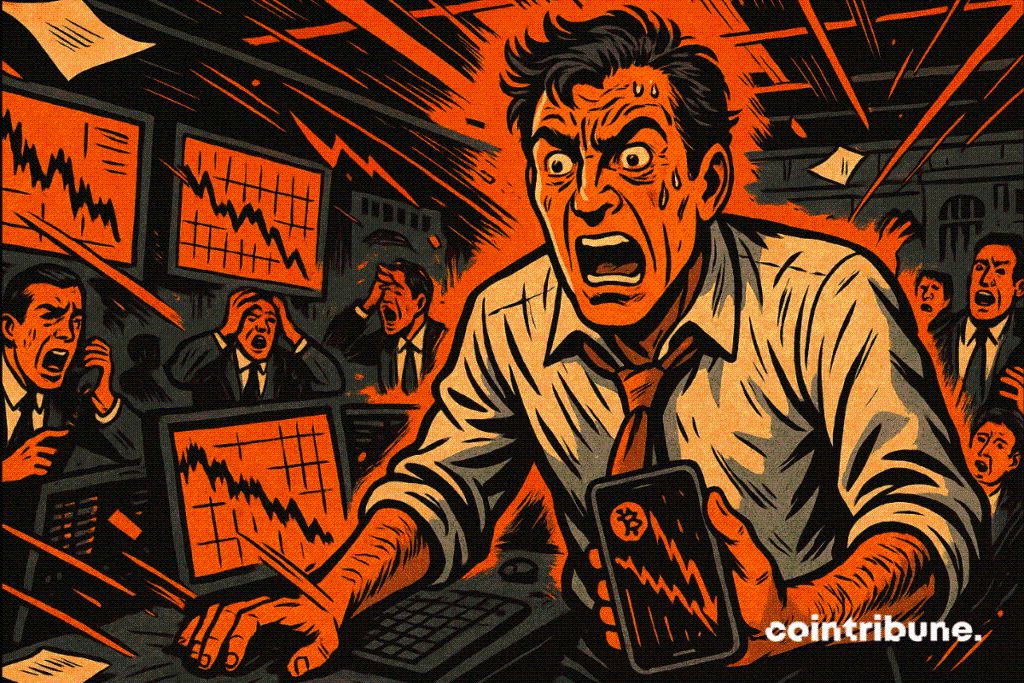Extreme Caution Sweeps Markets as Equities and Crypto Dive
A wave of caution swept through markets on Thursday, rattling U.S. stocks and pushing investors away from higher-risk assets. The retreat extended into crypto assets, with Bitcoin falling below $85K and reflecting the overall risk-off sentiment.

In brief
- U.S. markets experienced a sharp sell-off with the S&P 500 losing roughly $2 trillion in just a few hours.
- Investor sentiment dropped dramatically as the Crypto Fear and Greed Index fell to 14 signaling extreme caution.
- Analysts noted the drop reflected shifting sentiment and defensive positioning rather than a single news event.
Equities and Crypto Hit by Sharp Reversals
The Kobeissi Letter reported on X that U.S. markets experienced their fastest reversal since Liberation Day, with the S&P 500 losing roughly $2 trillion in market value within five hours. The index closed nearly 4% lower, while Nvidia—despite a recent earnings-driven surge—also dropped sharply, finishing more than 8% down.
Wider market signals indicated mounting concern, with the Crypto Fear and Greed Index falling to 14, signaling extreme caution. The move was striking because the S&P 500 remained just 6% below its recent high. Despite relatively modest price declines, investor confidence had eroded quickly, showing how sentiment can sour even when markets hover near their peaks.
Crypto faced its own pressure as liquidations climbed to roughly $829 million. High leverage amplified the decline, pushing Bitcoin down to around $82,000—its lowest level since mid-April—showing how sensitive the market is to sudden moves.
Market Mechanics and Leverage Amplify the Downturn
Giving details on what could have triggered the downturn, analysts at The Kobeissi Letter noted that the only notable update during the session was a headline confirming the release date of the US November jobs report. While the drop accelerated afterward, the analysts suggested the headline was only partially responsible. They viewed the move as largely reflecting internal market dynamics and broader selling pressure rather than a single news event.
Kobeissi also pointed to the elevated use of leverage, particularly within crypto markets. While earlier declines had been concentrated in crypto alone, Thursday’s drop was far more synchronized. With liquidations now approaching $1 billion per day, the effect has become increasingly amplified, intensifying the emotional swings driving market behavior.
Tim Sun, senior researcher at HashKey Group, said the drop did not seem tied to any major news event . He explained that the market’s weakness was driven by shifting sentiment and tighter liquidity. Traders had positioned defensively, buying put options ahead of Nvidia’s earnings and the upcoming US labor data, which amplified selling as the market reacted.
Sun added that “trend-following strategies further amplified the decline as prices subsequently broke through key technical levels.”
Fed Moves and Data to Influence Crypto Markets
Looking ahead, Chung from Presto noted that if strain within the private-credit market begins to spread, it could push the Federal Reserve toward supporting a rate cut at the December Federal Open Market Committee meeting, which would likely improve the outlook for risk-focused assets, with crypto expected to benefit as well. Despite this, expectations for a December rate cut have currently dropped to 35%.
Tim Sun added that a more favorable market tone would depend on whether upcoming economic data supports easing. While a rate cut could help calm markets, he noted that a sustained rebound would still require broader macroeconomic support.
With confidence shaky, many expect uneven trading as investors adjust their positions heading into the final weeks of the year.
Disclaimer: The content of this article solely reflects the author's opinion and does not represent the platform in any capacity. This article is not intended to serve as a reference for making investment decisions.
You may also like
Ethereum Updates Today: Buterin Moves ETH to Safeguard Privacy Against Major Financial Players and Quantum Threats
- Ethereum co-founder Vitalik Buterin donated 128 ETH ($760,000) to privacy-focused apps Session and SimpleX Chat, emphasizing decentralized metadata protection and user-friendly access. - Recent 1,009 ETH transfer to Railgun protocol sparked speculation about asset reallocation, though control remains with Buterin amid mixed Ethereum price trends. - Buterin warns of existential risks: 10.4% institutional Ether ownership and quantum computing threats by 2028, advocating layered security for Ethereum's desi

The Psychological Factors Influencing Retail Investors’ Actions in Cryptocurrency Markets
- Crypto markets are shaped by behavioral finance, where retail investors drive volatility through FOMO, herd behavior, and overconfidence. - The PENGU token exemplifies this dynamic, surging 480% in July 2025 but plummeting 28.5% by October due to emotional trading cycles. - Social media amplifies emotional contagion, with traders checking prices 14.5 times daily, while financial literacy mitigates bias susceptibility. - Personality traits like neuroticism increase cognitive biases, and speculative narrat

Bitcoin News Today: Bitcoin's Unstable Holiday Periods Hide Average Gains of 6%
- Bitcoin's Thanksgiving-to-Christmas performance shows equal odds of rising or falling, with a 6% average seasonal return despite volatility. - Historical extremes include a 50% 2020 rally and 2022's 3.62% drop post-FTX collapse, amid a $2.49-to-$91,600 long-term surge since 2011. - 2025's $91,600 price reflects ongoing recovery from 2024's $95,531 peak, with institutional crypto adoption and macroeconomic factors shaping future trajectories. - Analysts advise dollar-cost averaging for retail investors, w

Australia Strikes a Balance Between Fostering Crypto Innovation and Safeguarding Investors with Updated Regulations
- Australia introduces 2025 Digital Assets Framework Bill to regulate crypto platforms under ASIC, creating "digital asset platform" and "tokenized custody platform" licenses. - The framework mandates custody standards, transparency requirements, and lighter regulations for small operators (<$5k per customer) to balance innovation with investor protection. - Global alignment with UAE and EU crypto regulations is emphasized, while addressing risks from past failures like FTX through stricter enforcement and

